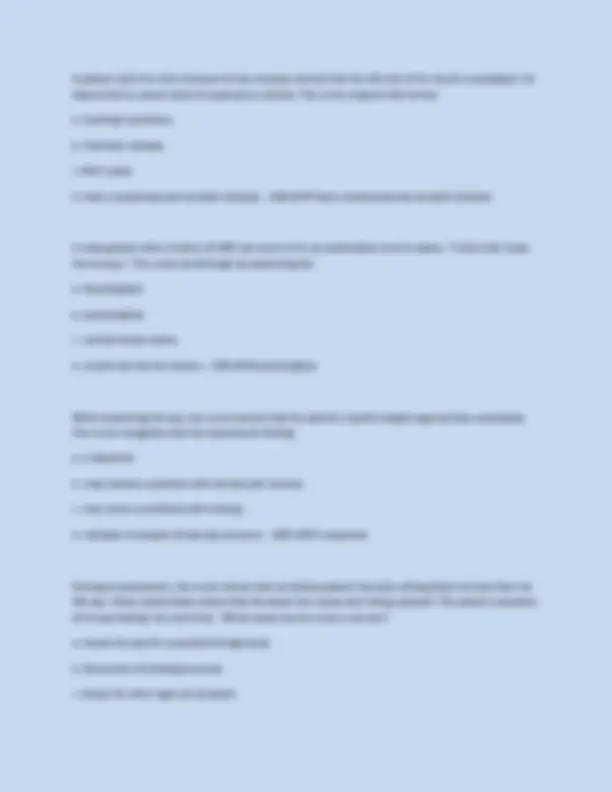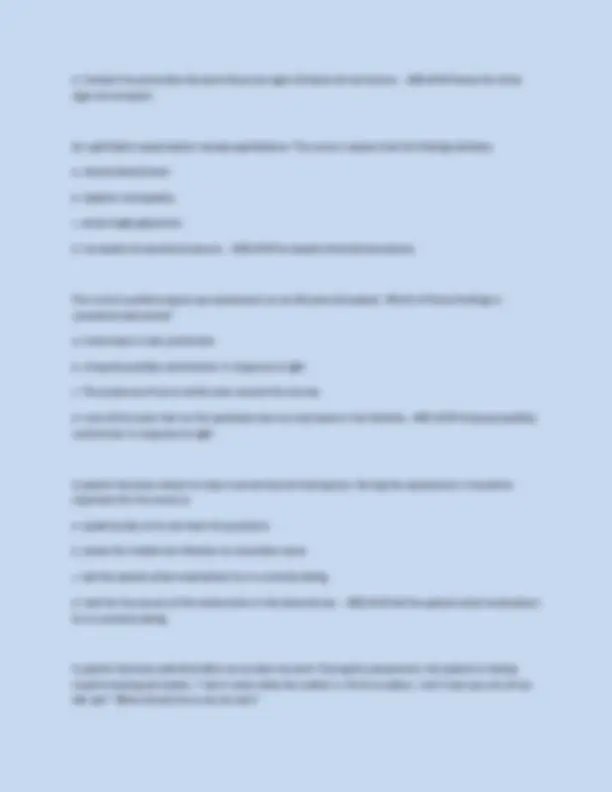





Study with the several resources on Docsity

Earn points by helping other students or get them with a premium plan


Prepare for your exams
Study with the several resources on Docsity

Earn points to download
Earn points by helping other students or get them with a premium plan
Community
Ask the community for help and clear up your study doubts
Discover the best universities in your country according to Docsity users
Free resources
Download our free guides on studying techniques, anxiety management strategies, and thesis advice from Docsity tutors
A series of multiple-choice questions and answers related to nursing assessment and examination. It covers various aspects of physical assessment, including skin, eyes, ears, nose, mouth, and abdomen. The questions are designed to test knowledge of common findings, normal variations, and potential pathologies related to these body systems. This resource can be valuable for nursing students preparing for exams or practicing their assessment skills.
Typology: Exams
1 / 7

This page cannot be seen from the preview
Don't miss anything!




The nurse is bathing an 80-year-old man and notices that his skin is wrinkled, thin, lax, and dry. This finding would be related to which factor?
a. Increased vascularity of the skin in the elderly
b. Increased numbers of sweat and sebaceous glands in the elderly
c. An increase in elastin and a decrease in subcutaneous fat in the elderly
d. An increased loss of elastin and a decrease in subcutaneous fat in the elderly - ANS-✔✔An increased loss of elastin and a decrease in subcutaneous fat in the elderly
A patient comes to the clinic and tells the nurse that he has been confined to his recliner chair for about three days with his feet down and he wants the nurse to evaluate his feet. During the assessment, the nurse might expect to find
a. pallor.
b. coolness.
c. distended veins
d. prolonged capillary filling time. - ANS-✔✔distended veins
The nurse notices that a school-aged child has bluish-white, red-based spots in her mouth that are elevated about 1 mm to 3 mm. What other signs would the nurse expect to find in this patient?
a. A pink, papular rash on the face and neck
b. Pruritic vesicles over her trunk and neck
c. Hyperpigmentation on the chest, abdomen, and the back of the arms
d. A red-purple, maculopapular, blotchy rash behind the ears and on the face - ANS-✔✔A red-purple, maculopapular, blotchy rash behind the ears and on the face
The nurse notices that a patient has a solid, elevated, circumscribed lesion that is less than 1 cm in diameter. When documenting this finding, the nurse would report this as a
a. bulla.
b. wheal.
c. wheal.
d. papule. - ANS-✔✔papule.
A 65-year-old man with emphysema and bronchitis has come to the clinic for a follow-up appointment. On assessment, the nurse might expect to see which assessment finding?
a. Anasarca
b. Scleroderma
c. Pedal erythema
d. Clubbing of the nails - ANS-✔✔Clubbing of the nails
A 19-year-old college student is brought to the emergency department with a severe headache he describes as "like nothing I've ever had before." His temperature is 104° F, and he has a stiff neck. The nurse looks for other signs and symptoms of which problem?
a. Head injury
b. Cluster headache
c. Migraine headache
d. Meningeal inflammation - ANS-✔✔Meningeal inflammation
During an examination of a female patient, the nurse notes lymphadenopathy and suspects an acute infection. Acutely infected lymph nodes would be
a. clumped.
b.unilateral.
c. firm but freely movable.
d. firm and nontender. - ANS-✔✔firm but freely movable.
d. Contact the prescriber because these are signs of basal cell carcinoma. - ANS-✔✔Assess for other signs of ectropion.
An ophthalmic examination reveals papilledema. The nurse is aware that this finding indicates
a. retinal detachment.
b. diabetic retinopathy.
c. acute-angle glaucoma.
d. increased intracranial pressure. - ANS-✔✔increased intracranial pressure.
The nurse is performing an eye assessment on an 80-year-old patient. Which of these findings is considered abnormal?
a. A decrease in tear production
b. Unequal pupillary constriction in response to light
c. The presence of arcus senilis seen around the cornea
d. Loss of the outer hair on the eyebrows due to a decrease in hair follicles - ANS-✔✔Unequal pupillary constriction in response to light
A patient has been shown to have a sensorineural hearing loss. During the assessment, it would be important for the nurse to
a. speak loudly so he can hear the questions
b. assess for middle ear infection as a possible cause.
c. ask the patient what medications he is currently taking.
d. look for the source of the obstruction in the external ear. - ANS-✔✔ask the patient what medications he is currently taking.
A patient has been admitted after an accident at work. During the assessment, the patient is having trouble hearing and states, "I don't know what the matter is. All of a sudden, I can't hear you out of my left ear!" What should the nurse do next?
a. Make note of this finding for report to the next shift.
b. Prepare to remove cerumen from the patient's ear.
c. Notify the patient's healthcare provider.
d. Irrigate the ear with rubbing alcohol. - ANS-✔✔Notify the patient's healthcare provider
An assessment of a 23-year-old patient reveals the following: an auricle that is tender and reddish-blue in color with small vesicles. Additional information the nurse would need to know includes which of these?
a. Any change in the ability to hear
b. Any recent drainage from the ear
c. Recent history of trauma to the ear
d. Any prolonged exposure to extreme cold - ANS-✔✔Any prolonged exposure to extreme cold
The nurse is performing an ear examination of an 80-year-old patient. Which of these would be considered a normal finding?
a. A high-tone frequency loss
b. Increased elasticity of the pinna
c. a thin, translucent membrane
d. A shiny, pink tympanic membrane - ANS-✔✔A high-tone frequency loss
The nurse is assessing a 3-year-old for "drainage from the nose." On assessment, it is found that there is a purulent drainage from the left nares that has a very foul odor and no drainage from the right nares. The child is afebrile with no other symptoms. What should the nurse do next?
a. Refer to the physician for an antibiotic order.
b. Have the mother bring the child back in 1 week.
c. Perform an otoscopic examination of the left nares.
d. Tell the mother that this is normal for children of this age. - ANS-✔✔Perform an otoscopic examination of the left nares.
a. document the presence of hepatomegaly.
b. ask additional history questions regarding his alcohol intake.
c. describe this as an enlarged liver and refer him to a physician.
d. consider this a normal finding and proceed with the examination. - ANS-✔✔consider this a normal finding and proceed with the examination.
The nurse is reviewing statistics for lactose intolerance. In the United States, the incidence of lactose intolerance is higher in adults of which ethnic group?
a. African-Americans
b. Hispanics
c. Whites
d. Asians - ANS-✔✔African-Americans
During an abdominal assessment, the nurse would consider which of these findings as normal?
a. The presence of a bruit in the femoral area
b. A tympanic percussion note in the umbilical region
c. A palpable spleen between the ninth and eleventh ribs in the left midaxillary line
d. A dull percussion note in the left upper quadrant at the midclavicular line - ANS-✔✔A tympanic percussion note in the umbilical region
During a health history, the patient tells the nurse, "I have pain all the time in my stomach. It's worse two hours after I eat, but it gets better if I eat again!" The nurse suspects that the patient has which condition, based on these symptoms?
a. Appendicitis
b. Gastric ulcer
c. Duodenal ulcer
d. Cholecystitis - ANS-✔✔Duodenal ulcer